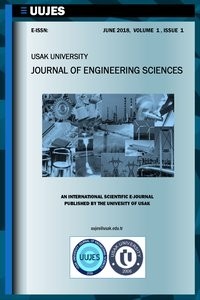Mechanical Properties Evaluation of Concrete with Crumb Rubber Particles used as Fine Aggregate
Mechanical Properties Evaluation of Concrete with Crumb Rubber Particles used as Fine Aggregate
crumb rubber, flexural strength, compression strength impact resistance, damping ratio, natural frequency,
___
- 1. Gupta, S.; Mohan, K.; Prasad, R.; Gupta, S.; Kansal, A. Solid waste management in India: Options and opportunities. Resour. Conserv. Recycl. 1998, 24, 137–154.
- 2. Rattanapan, S.; Pasetto, P.; Pilard, J.; Tanrattanakul, V. Polyurethane foams from oligomers derived from waste tire crumbs and poly caprolactone diols. J. Appl. Polym. Sci. 2016, 133 (47), 1-10.
- 3. Littleton ,P.E. Building with Tire Bales: Addressing Some Engineering Concerns; Innovative Technical Solutions: Colorado, US, 2005.
- 4. Raghavan, D.; Huynh, H.; Ferraris, C.F. Workability, mechanical properties and chemical stability of a recycled tire rubber-filled cementitious composite. J. Mater. Sci. 1998, 33, 1745–1752. 5. Skripkiūnas, G.; Grinys, A.; Miškinis, K. Damping properties of concrete with rubber waste additives. Mater. Sci. 2009, 15, 266–272.
- 6. Bala, A.; Sehgal, V.K.; Saini, B. Effect of fly ash and waste rubber on properties of concrete composite. Concr. Res. Lett. 2014, 5, 842–857.
- 7. Gupta, T.; Chaudhary, S.; Sharma, R.K. Assessment of mechanical and durability properties of concrete containing waste rubber tire as fine aggregate. Constr. Build. Mater. 2014, 73, 562–574.
- 8. Gupta, T.; Chaudhary, S.; Sharma R K. Impact resistance of concrete containing waste rubber fiber and silica fume. Int. J. Impact Eng. 2015, 83, 76–87.
- 9. Torgal, P.F.; Shasavandi, A.; Jalali, S. Eco-efficient concrete using industrial wastes: A review. Mater. Sci. Forum 2012, 730, 581–586.
- 10. Karakurt, C. Microstructure properties of waste tire rubber composites: An overview. J. Mater. Cycles Waste Manag. 2015, 17, 422–433.
- 11. Kishore, R.; Bhikshma, V.; Prakash, P. Study on strength characteristics of high strength rice husk ash concrete. Procedia Eng. 2011, 14, 2666–2672.
- 12. He, P.; Shi, C.; Tu, Z.; Poon, C.; Zhang, J. Effect of further water curing on compressive strength and microstructure of CO2-cured concrete. Cem. Concr. Compos. 2016, 72, 80–88. 13. Alciatore, D.; Histand, M. Introduction to Mechatronics and Measurement Systems; McGraw-Hill: Dubuque, IA, USA, 2007.
- 14. Aiello, M.; Leuzzi, F. Waste tyre rubberized concrete: Properties at fresh and hardened state. Waste Manag. 2010, 30, 1696–1704.
- 15. Faraz, I.M.; Jain, U.; Jain, K.; Singh, S. Effect of crumb rubber material on concrete mix. SSRG Int. J. Civ. Eng. 2015, 2, 14–17.
- 16. Sofi, A. Effect of waste tire rubber on mechanical and durability properties of concrete—A review. Ain Shams Eng. J. 2018, 9, 2691–2700.
- 17. Gerges, N.; Issa, C.; Fawaz, S. Rubber concrete: Mechanical and dynamical properties. Case Stud. Constr. Mater. 2018, 9, 184.
- 18. Rodd, J.; Khabbaz, H.; Vessalas, K. Enhancing mechanical performance of rubberised concrete pavements with sodium hydroxide treatment. Mater. Struct. 2016, 49, 813–827.
- 19. Serge, N.; Joekes, I.; Galves, I.; Rodrigues, J. Rubber-mortar composites: Effect of composition on properties. J. Mater. Sci. 2004, 39, 3319–3327.
- 20. Li, H.; Xu, Y.; Chen, P.; Ge, J.; Wu, F. Impact energy consumption of high-volume rubber concrete with silica fume. Adv. Civ. Eng. 2019, 2019, 1728762.
- 21. Zheng, L.; Huo, X.S.; Yuan, Y. Experimental investigation on dynamic properties of rubberized concrete. Constr. Build. Mater. 2008, 22, 939–947.
- 22. Holmes, N.; Browne, A.; Montague, C. Acoustic properties of concrete panels with crumb rubber as a fine aggregate replacement. Constr. Build. Mater. 2014, 73, 195–204.
- 23. Chandran, V.; Nagarajan, L.; Thomas, M. Evaluation of vibration damping behavior of different sizes of waste tyre rubber in natural rubber composites. J. Compos. Mater. 2017, 52, 2493–2501.
- Başlangıç: 2018
- Yayıncı: Uşak Üniversitesi
A case of risk assessment by using Fine-Kinney method in sub-leather processing
Ayhan MİLLİ, Serdar SALMAN, Erhan SANCAK
ASSESSMENT OF NOISE PROBLEM IN NONWOVEN INDUSTRY
Recommendations for Making Okada Safer and Better for Urban Mobility
Mechanical Properties Evaluation of Concrete with Crumb Rubber Particles used as Fine Aggregate
